Why Your Social Media Reports Are Missing the Mark
Your current social media reports likely feel more like a chore than a strategic exercise. If you're stuck manually pulling data into spreadsheets or relying on native platform analytics, you're only seeing a fraction of the story. This surface-level data rarely connects social media activity to tangible business outcomes, leaving you unable to justify ROI or make informed decisions. The core problem is that basic reports are disconnected from real-world performance, offering vanity metrics instead of actionable insights.
This guide moves beyond generic feature lists to provide a detailed analysis of the best social media reporting tools available. We will dissect each platform's strengths and, just as importantly, its limitations. You will learn how specific tools address unique challenges, from multi-client reporting for agencies to in-depth competitive analysis for enterprise brands and API access for developers.
Our goal is to help you select a solution that transforms your reporting process from a data dump into a powerful driver of strategy. We will cover implementation considerations, practical use cases, and the nuances of each tool's data visualization capabilities. By the end, you'll have a clear understanding of which platform aligns with your specific needs, budget, and technical requirements.
1. Sprout Social
Sprout Social positions itself as a premium, all-in-one social media management solution, and its reporting capabilities are a core reason why. It excels for agencies and established brands that require deep, granular insights across multiple profiles and platforms. The platform's strength lies in its ability to consolidate complex data into clean, presentation-ready reports that are easy for stakeholders to understand. Its suite of listening and analytics tools makes it one of the most robust social media reporting tools available for businesses focused on data-driven growth.

Implementation is straightforward due to its intuitive user interface, but unlocking its full potential requires dedicating time to custom report configuration. A key use case is for marketing teams managing multiple client accounts; the tool allows for the creation of unique reporting dashboards for each client, tracking specific KPIs without crossover.
Key Considerations
- Best For: Medium to large businesses and marketing agencies needing detailed, customizable reports and team collaboration features.
- Pricing: Plans start at $249 per month (billed annually) for the Standard plan. Advanced reporting and listening features are available in higher-tier plans like Professional and Advanced, which can become a significant investment.
- Limitations: The primary drawback is the cost. Small businesses or solo entrepreneurs may find the price prohibitive compared to other tools. Some of the more advanced analytics, like competitive analysis reports, are locked behind the more expensive plans.
- Implementation Tip: When setting up, immediately connect all your primary social profiles and take advantage of the tag and campaign tracking features. Applying tags to inbound and outbound messages from the start provides richer, more segmented data for your reports later. This allows you to effectively measure the performance of specific marketing campaigns.
For teams looking to build out their reporting strategy, understanding what to include is crucial. You can dive deeper into structuring your reports with this social media analytics report template to ensure you're tracking the right metrics.
Website: https://sproutsocial.com/
2. Hootsuite
Hootsuite is one of the most established names in social media management, known for its comprehensive scheduling and monitoring capabilities. While often recognized for its content calendar, its analytics suite makes it a powerful contender among social media reporting tools. It is particularly effective for teams managing a high volume of content across a wide array of social networks, providing a centralized dashboard to track performance and generate customizable reports. The platform’s ability to integrate with hundreds of apps extends its reporting functions, allowing users to pull in data from various marketing tools.
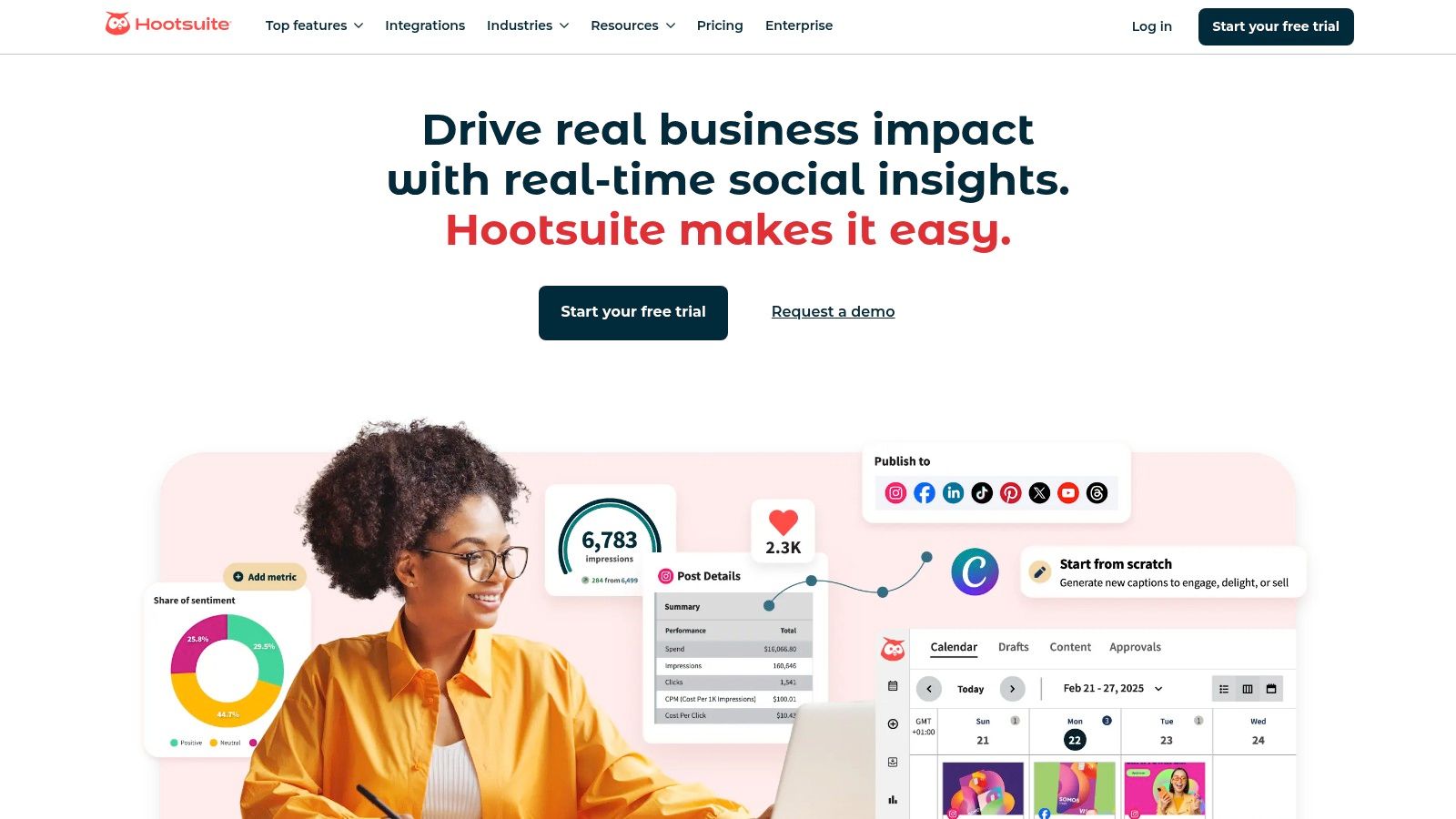
Setup is straightforward, but the user interface, while powerful, can have a steeper learning curve compared to more modern UIs. A key use case is for content teams that need to demonstrate the ROI of their social media efforts. Hootsuite's reports can be configured to highlight key metrics like engagement rate, reach, and follower growth, and can be scheduled for automatic delivery to stakeholders.
Key Considerations
- Best For: Businesses of all sizes and agencies that prioritize content scheduling alongside robust, integrated reporting across many platforms.
- Pricing: Plans start at $99 per month for the Professional plan. More advanced analytics, team features, and unlimited reporting are available in the higher-tier Team and Enterprise plans.
- Limitations: The user interface can feel dated and less intuitive for new users. Accessing the most powerful analytics and social listening reports requires subscribing to the more expensive plans, which may be out of reach for smaller teams.
- Implementation Tip: Use the Hootsuite App Directory early on. Integrating tools like Google Analytics or specialized listening apps can significantly enrich your reports. Also, utilize the bulk scheduler's tagging feature to categorize posts by campaign or content pillar, which will allow for more granular and insightful performance analysis later.
Website: https://hootsuite.com/
3. Buffer
Buffer is widely recognized for its clean interface and straightforward scheduling capabilities, but it also offers powerful and accessible reporting features. It stands out for small to medium-sized businesses, content creators, and marketing teams who need clear, actionable insights without the complexity of enterprise-level platforms. The platform’s strength is in simplifying performance data, allowing users to quickly see what content resonates and optimize their strategy accordingly. Its analytics are integrated directly into the publishing workflow, making it one of the most user-friendly social media reporting tools for growing brands.
Setup is exceptionally fast, allowing you to connect accounts and begin gathering data in minutes. A key use case is for a small business owner who manages their own social media; Buffer provides essential metrics like reach, engagement rates, and top-performing posts in a format that is easy to digest and act upon without needing a dedicated data analyst.
Key Considerations
- Best For: Small businesses, solopreneurs, and content creators who prioritize ease of use and need core performance metrics.
- Pricing: A free plan is available for up to three channels. Paid plans start at $6 per month per channel, with analytics features included in the Essentials plan ($12/month/channel). Team and Agency plans offer more robust collaboration features.
- Limitations: The analytics are not as deep as competitors like Sprout Social. It lacks advanced features such as in-depth competitor analysis, keyword listening, or sentiment analysis. The reporting is more focused on post-performance than on broad strategic insights.
- Implementation Tip: When you start, use Buffer’s "Top Posts" filter to immediately identify your most engaging content formats. Replicate these successful formats and topics in your upcoming content calendar. This simple feedback loop is a core strength of Buffer’s design and helps improve performance quickly.
For those focused on building a consistent presence, understanding the fundamentals of content planning is key. You can explore effective strategies in this guide to scheduling social media posts to complement Buffer’s capabilities.
Website: https://buffer.com/
4. Brandwatch
Brandwatch is an enterprise-level digital consumer intelligence platform, where social media reporting is a function of its vast listening and analytics capabilities. It excels at large-scale conversation analysis, enabling global brands to tap into millions of online discussions to understand public perception, track brand health, and identify market trends. Rather than just reporting on owned channel performance, Brandwatch provides a macro view of your brand’s place in the wider digital ecosystem. This makes it one of the most powerful social media reporting tools for strategic market research and crisis management.
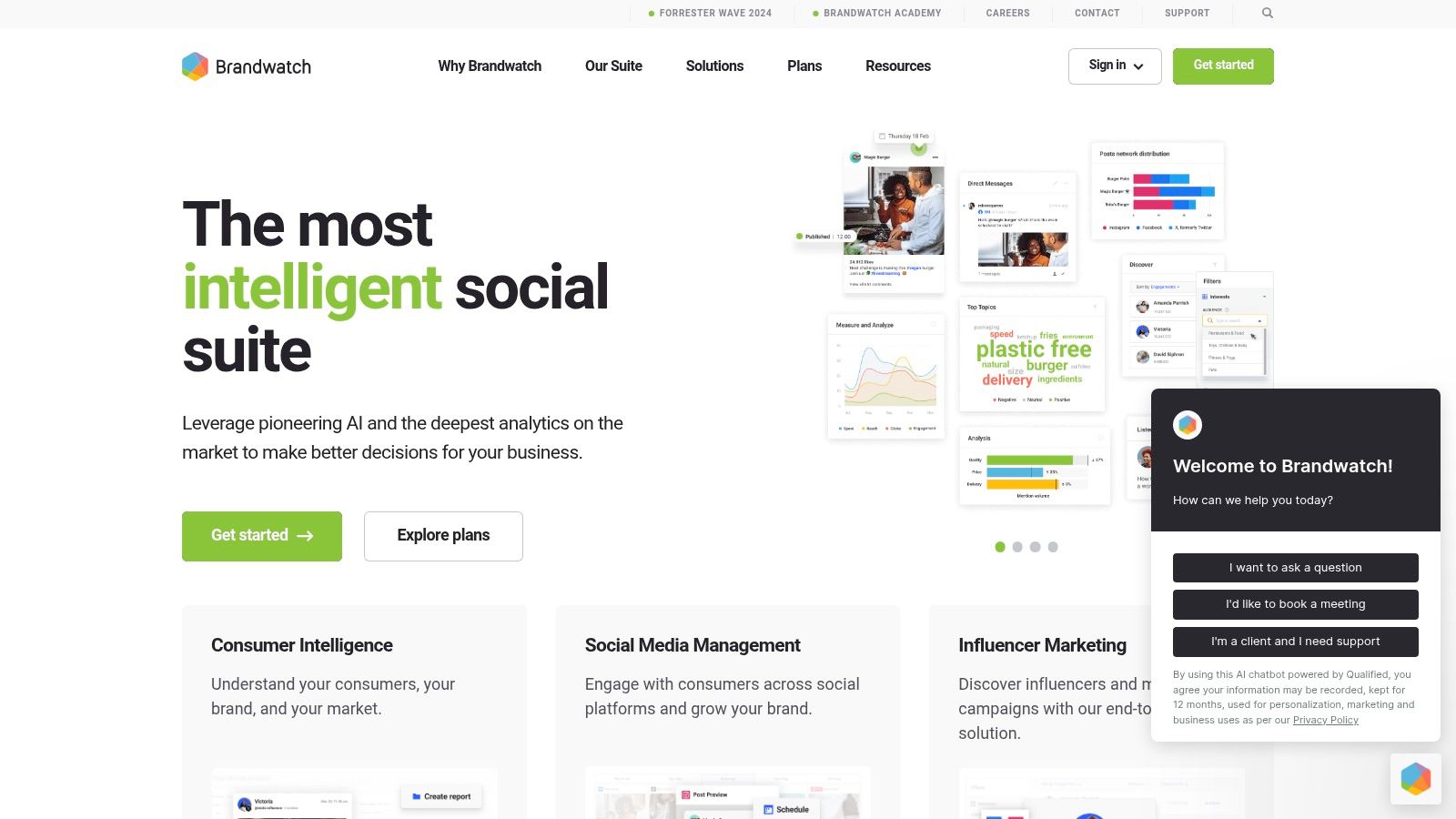
The platform is complex, and its true value is unlocked by data analysts or researchers dedicated to building sophisticated queries and interpreting the results. A key use case is a product development team using Brandwatch to monitor unsolicited consumer feedback about a competitor's new launch. By analyzing sentiment and specific feature mentions, the team can generate reports that directly inform their own product roadmap.
Key Considerations
- Best For: Large enterprises and market research firms needing deep, AI-driven consumer insights, competitive intelligence, and advanced social listening.
- Pricing: Brandwatch offers custom pricing based on mentions volume, data access, and user seats. It is a premium-priced solution, with costs typically starting in the thousands of dollars per month, positioning it as a significant enterprise investment.
- Limitations: The primary barrier is its high cost and steep learning curve. It is not designed for simple social media management or basic performance reporting, which can make it overkill for small to medium-sized businesses. Its power lies in analysis, not day-to-day content scheduling.
- Implementation Tip: Start with narrowly defined queries. Instead of a broad search for your brand name, create a specific query to track sentiment around a new marketing campaign or a particular product feature. Use Boolean operators to filter out noise and refine your data set. This approach yields more actionable insights and helps you learn the platform's query logic more effectively.
Website: https://www.brandwatch.com/
5. Zoho Social
Zoho Social positions itself as a powerful, yet budget-friendly, social media management platform that shines for businesses already invested in the Zoho ecosystem. Its reporting features are comprehensive, providing a clear view of performance across all major channels. The platform is particularly strong in tracking how social media efforts translate into website traffic, with detailed analytics on referral sources. This focus on tangible outcomes makes it one of the more practical social media reporting tools for small to medium-sized businesses aiming to justify their social media spend.
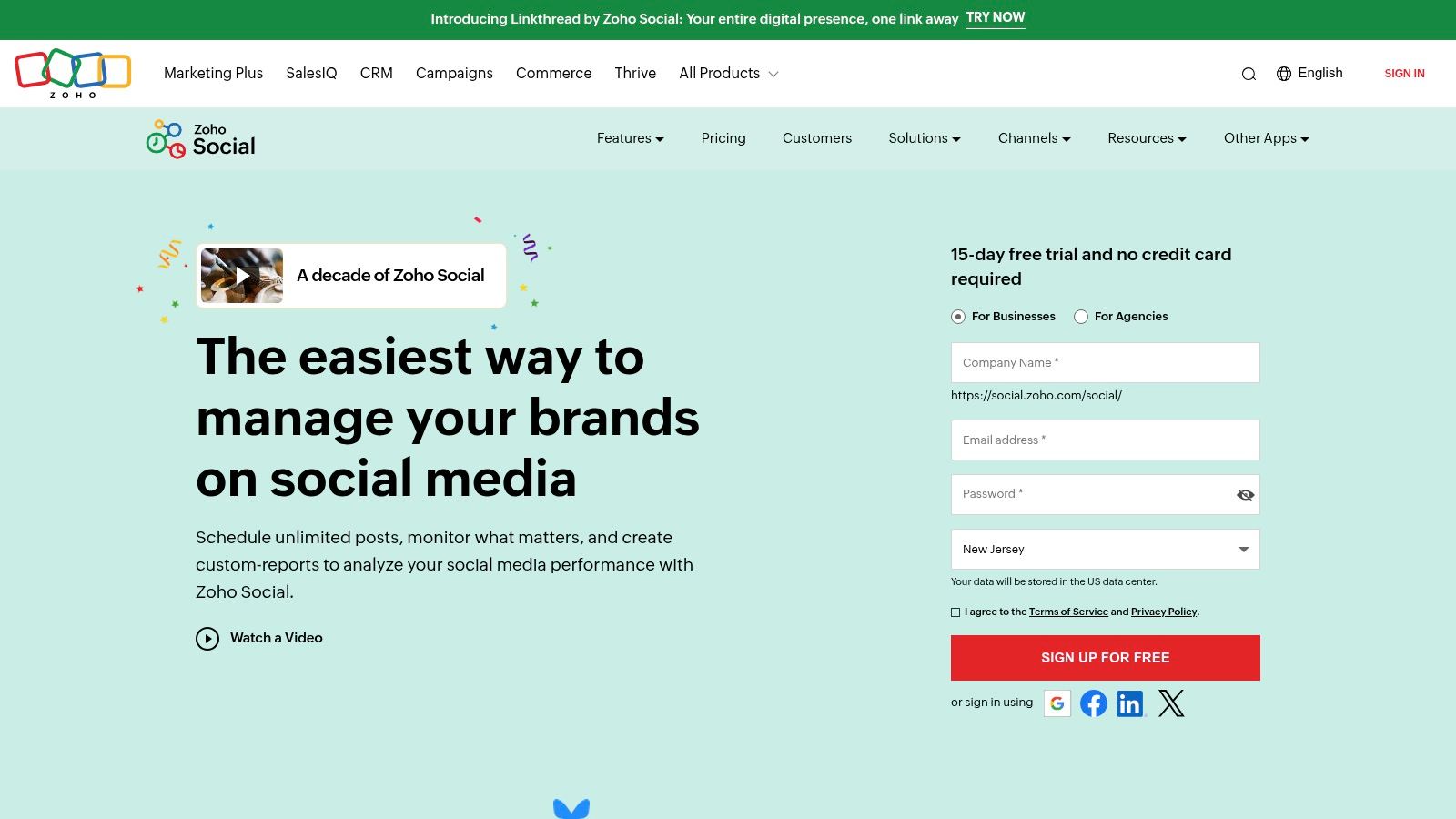
Setup is user-friendly, and the real value emerges when it's connected with other Zoho products like Zoho CRM or Zoho Analytics, creating a unified business intelligence dashboard. A key use case is for marketing teams that need to demonstrate direct ROI from social campaigns. By tracking clicks and conversions through to the CRM, users can attribute revenue to specific posts or platforms, a feature often reserved for more expensive tools.
Key Considerations
- Best For: Small to medium-sized businesses, especially those already using other Zoho applications, seeking an affordable yet robust reporting solution.
- Pricing: Offers a limited free plan. Paid plans are highly competitive, starting at $10 per month (billed annually) for the Standard plan. Agency plans are also available.
- Limitations: The free version has notable restrictions, lacking support for platforms like TikTok and Pinterest. While the reporting is solid, it may not offer the same depth of competitive analysis or advanced sentiment analysis found in premium-priced alternatives.
- Implementation Tip: After connecting your social profiles, immediately configure the Bitly integration for link shortening. This not only creates cleaner links but also provides a separate layer of click-tracking data that can be used to validate the platform's native analytics and monitor traffic performance with greater accuracy.
Website: https://www.zoho.com/social/
6. Keyhole
Keyhole specializes in real-time social listening and analytics, making it a powerful tool for brands focused on campaign tracking and competitive benchmarking. It shines in its ability to monitor hashtags, keywords, and accounts as events unfold, providing instant insights into audience sentiment and engagement. While some all-in-one platforms include listening as a feature, Keyhole builds its entire reporting suite around this capability, offering deeper data on reach, impressions, and top influencers related to specific topics. This makes it one of the most effective social media reporting tools for event marketing and brand monitoring.
The platform is designed for marketers who need to quickly prove the ROI of a campaign or understand a competitor's strategy. A key use case is for product launches or live events, where teams can set up a real-time tracker to visualize mentions, monitor brand sentiment, and identify user-generated content as it happens. The user-friendly interface simplifies the process of turning this live data into shareable reports.
Key Considerations
- Best For: Brands and agencies that heavily rely on hashtag campaigns, influencer marketing, and real-time event monitoring.
- Pricing: Custom pricing based on needs. Plans are tailored to data requirements, with options for individuals, teams, and enterprises. You must contact their sales team for a quote.
- Limitations: Its integrations with other marketing tools are not as extensive as larger, all-in-one platforms. The core focus is on listening and tracking rather than publishing or direct social media management, which may require a supplementary tool.
- Implementation Tip: Start by setting up trackers for your primary brand hashtags, competitor brand names, and key industry keywords. Let the tool run for a week to gather baseline data. This initial benchmark will make your future campaign reports much more impactful, as you can clearly demonstrate growth and changes in share of voice.
To get the most out of Keyhole's data, it's essential to track the right metrics. You can learn which metrics matter most by reading up on social media key performance indicators.
Website: https://keyhole.co/
7. Mention
Mention excels primarily as a media monitoring and social listening platform, but its integrated analytics suite makes it a powerful contender among social media reporting tools. Its core strength is tracking brand mentions, keywords, and competitors across a vast online landscape, including social media, blogs, forums, and news sites. This makes it invaluable for businesses focused on reputation management and understanding brand perception. The platform aggregates this listening data into customizable reports that visualize share of voice, sentiment analysis, and key conversation trends.
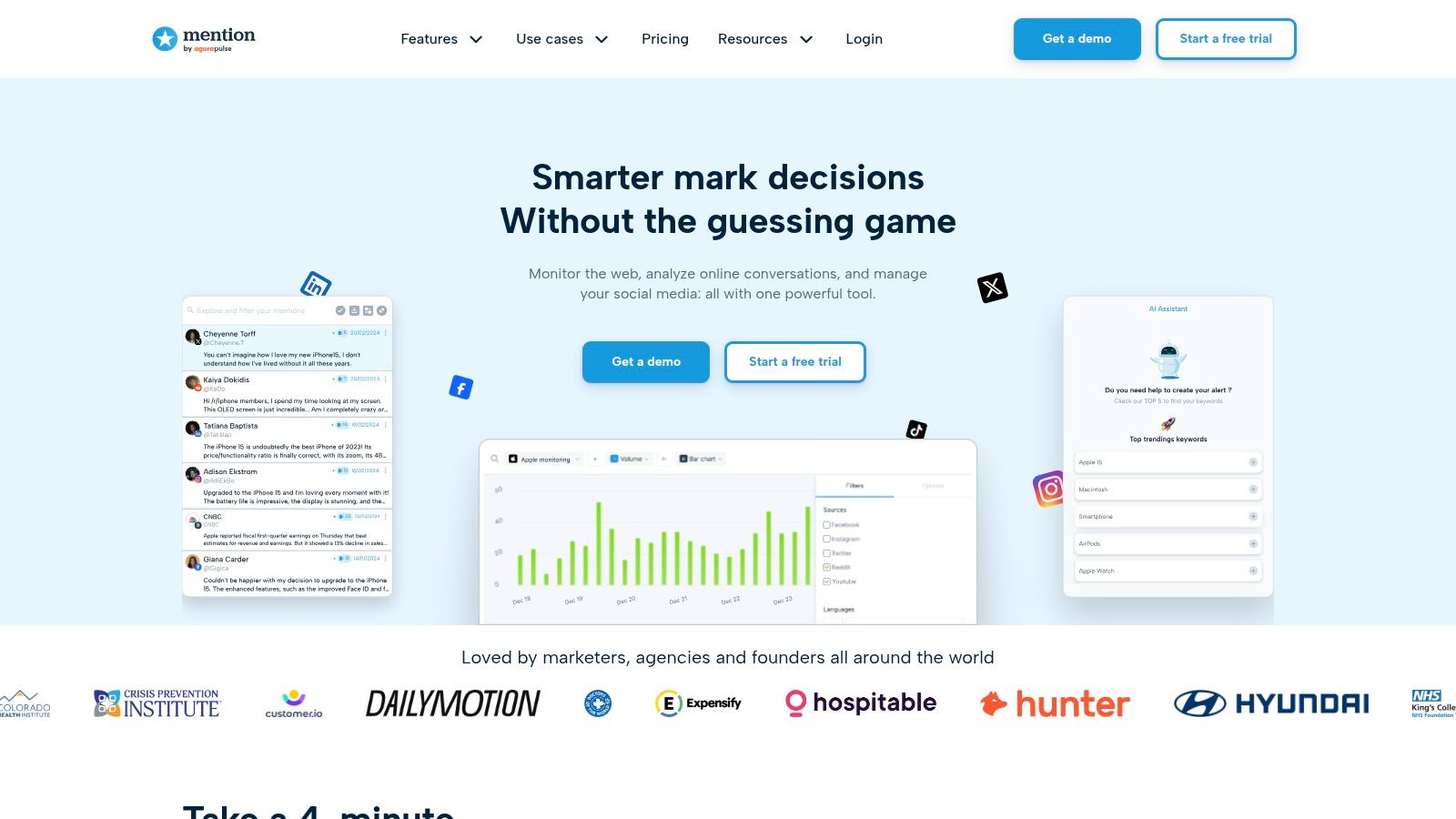
While its social media management features like scheduling are solid, the reporting truly shines when used to connect listening efforts with performance metrics. A key use case is for a PR or corporate communications team to track the impact of a press release or campaign by monitoring the volume and sentiment of resulting online conversations, then presenting these findings to stakeholders in a clear, data-backed report.
Key Considerations
- Best For: Brands and agencies prioritizing reputation management, competitive intelligence, and tracking brand awareness across the web, not just on social media.
- Pricing: A free plan is available with limited alerts. Paid plans start at $49 per month for the Solo plan, with more advanced features like historical data and API access available in the Pro and ProPlus plans.
- Limitations: Its native social media analytics are less comprehensive than all-in-one management platforms like Sprout Social. The primary focus is on listening data, so teams needing deep, channel-specific performance metrics might find it less robust. Integrations can also be more limited compared to competitors.
- Implementation Tip: Start by setting up highly specific alerts. Use boolean operators (AND, OR, NOT) in your keyword queries to filter out noise and capture only relevant mentions. For example, instead of just "Apple," use "Apple AND (iPhone OR MacBook) NOT pie" to refine your results and ensure your reports are based on accurate data.
Website: https://mention.com/
8. Brand24
Brand24 excels as a media monitoring and social listening platform, making it one of the most effective social media reporting tools for brands focused on reputation management and competitive intelligence. Rather than being an all-in-one management suite, its primary strength is tracking online mentions, sentiment, and share of voice across social media, news sites, blogs, and forums. The platform aggregates this data into insightful, automated reports that highlight trends, identify key influencers, and measure the impact of PR or marketing campaigns.
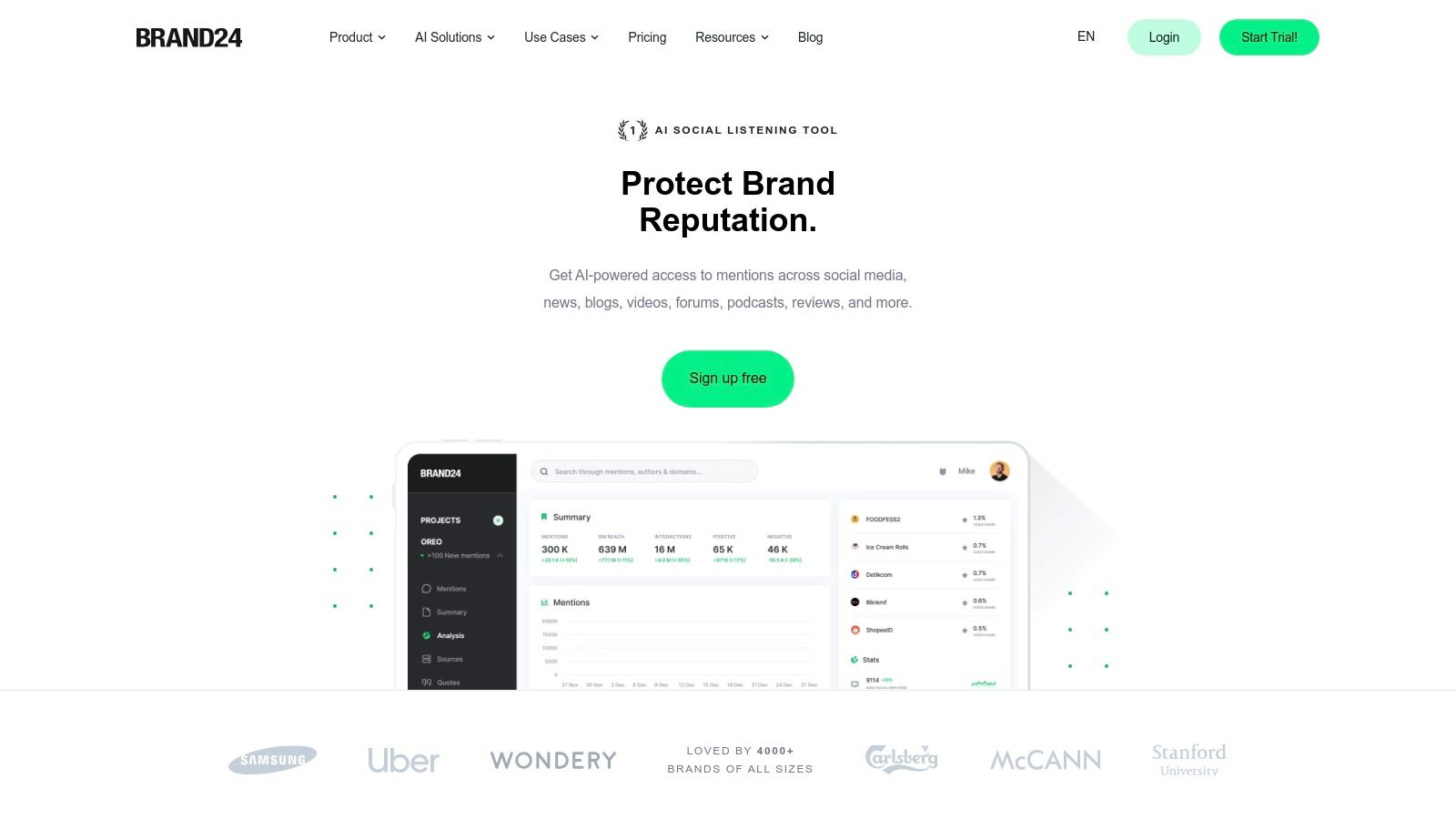
Its AI-powered insights provide a qualitative layer to quantitative data, helping users understand the context behind brand mentions. A key use case is for PR agencies or in-house communications teams needing to track the reach of a press release or manage a potential brand crisis. The tool provides real-time alerts for negative mentions, allowing for swift intervention.
Key Considerations
- Best For: Businesses of all sizes focused on brand monitoring, reputation management, and analyzing public sentiment.
- Pricing: Plans start at $79 per month for the Individual plan. More advanced features like sentiment analysis and PDF reports are available in the Team plan and higher tiers.
- Limitations: Its direct social media management capabilities, such as scheduling posts, are nonexistent as it is not designed for that purpose. Integrations are more limited compared to comprehensive suites like Sprout Social or Hootsuite.
- Implementation Tip: Upon setup, create separate projects for your brand, key competitors, and industry-specific hashtags. This segmentation is crucial for generating clean, comparative reports. Use the "Filter by Sentiment" feature from day one to quickly identify and address critical feedback or praise.
Website: https://brand24.com/
9. DashThis
DashThis positions itself as an automated marketing reporting tool first and a social media tool second. This distinction is crucial; it's designed for agencies and marketing departments that need to consolidate data from various channels like SEO, PPC, email marketing, and social media into a single, cohesive dashboard. While it may not offer the deepest social-native analytics, its strength lies in providing a high-level overview of how social media performance contributes to broader marketing goals. It’s one of the best social media reporting tools for teams that need to demonstrate ROI across the entire marketing funnel.
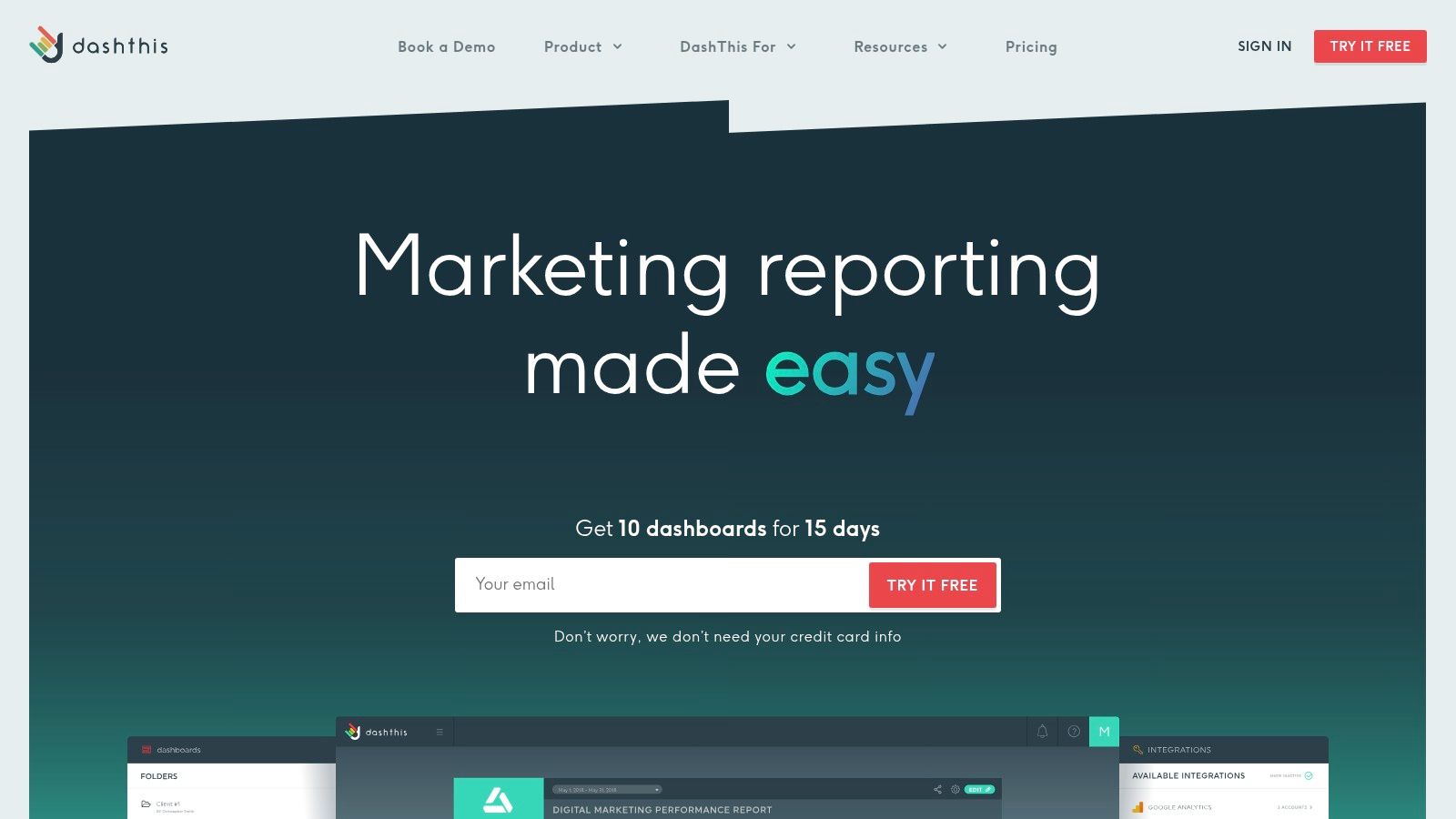
The platform is exceptionally user-friendly, with preset report templates and widgets that make dashboard creation quick and efficient. A key use case is for a marketing manager presenting monthly results to a C-suite executive; they can pull in Google Analytics traffic, Facebook Ads spend, and organic social engagement into one clean, automated report without needing to export multiple CSV files.
Key Considerations
- Best For: Marketing agencies and in-house teams that need to report on multi-channel campaigns and integrate social media data with other marketing analytics.
- Pricing: Plans are based on the number of dashboards, starting at $45 per month for 3 dashboards when billed annually. All plans include unlimited users and data sources.
- Limitations: Its focus is on breadth, not depth. If you need granular social media insights, like sentiment analysis or detailed competitor tracking, you will find it lacking compared to dedicated social platforms. It’s a reporting tool, not a management or listening suite.
- Implementation Tip: Start by connecting your most important data sources first, such as Google Analytics and your primary social ad accounts. Use the "comment" and "note" features within your dashboards to add context and explain performance trends. This transforms a data-heavy report into a strategic narrative for stakeholders.
Website: https://dashthis.com/
10. Socialinsider
Socialinsider excels at providing deep competitive analysis and content strategy insights, making it a go-to tool for data-driven marketers. It moves beyond standard performance metrics by using AI to identify your competitors' content pillars, showing you what topics resonate most effectively within your niche. This allows brands to benchmark their performance against the industry and uncover strategic gaps. For teams focused on optimizing content, Socialinsider is one of the most insightful social media reporting tools for turning raw data into actionable creative direction.
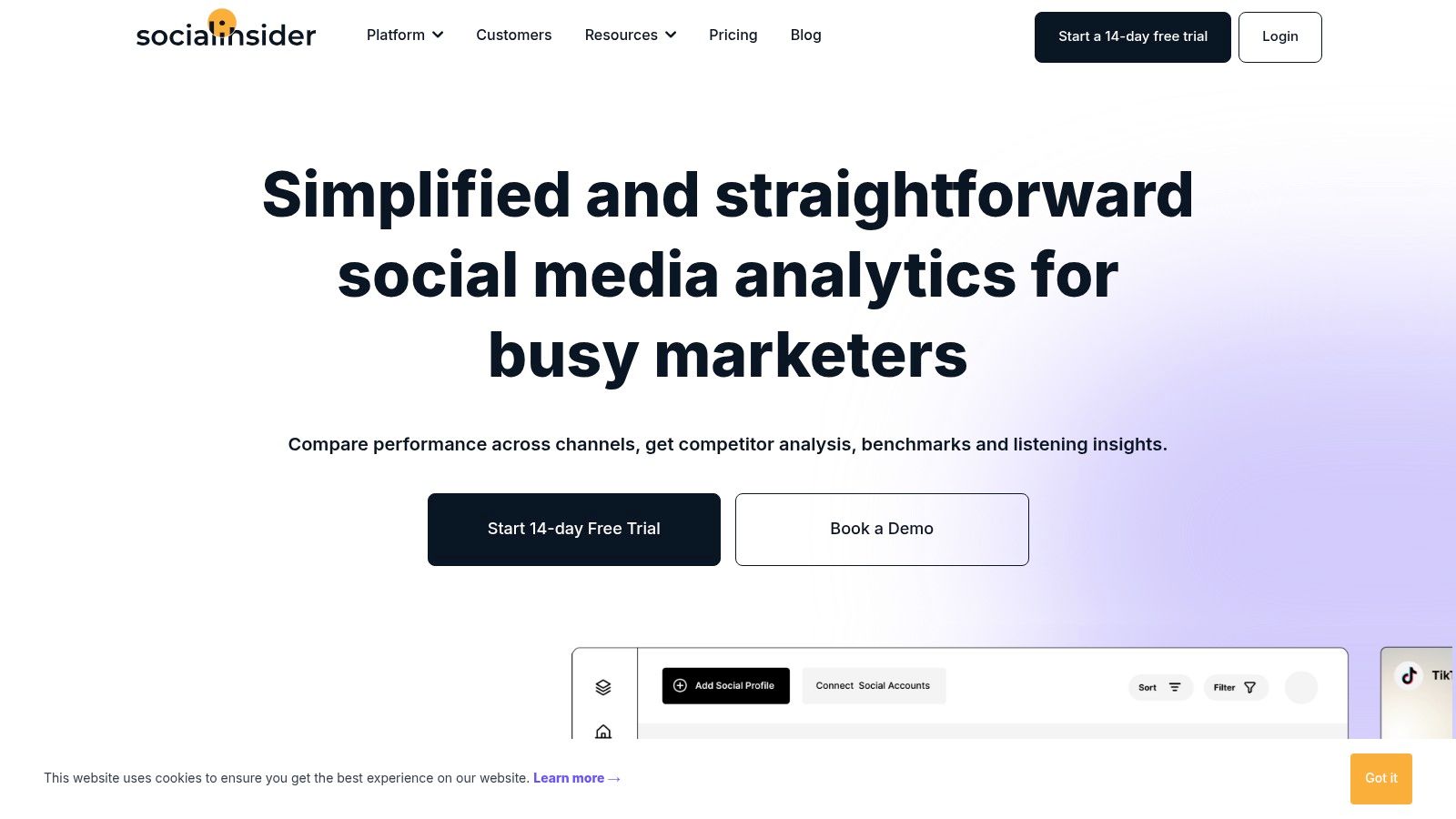
The platform is particularly useful for agencies and marketing teams that need to justify their content strategy with hard data. Its clean interface and customizable reporting features make it simple to build and share comprehensive reports on competitor activity, audience growth, and campaign performance, helping to align internal teams and educate stakeholders.
Key Considerations
- Best For: Digital marketing agencies and competitive brands that need in-depth competitor benchmarking and content performance analytics.
- Pricing: Plans start at $83 per month (billed annually). More advanced features like influencer analytics and API access are reserved for higher-tier plans.
- Limitations: The cost can be a barrier for smaller businesses or freelancers. While powerful, its focus is heavily on analytics and reporting; it lacks the publishing and engagement features found in all-in-one platforms.
- Implementation Tip: Start by adding 3-5 of your top competitors. Use the "Content Pillars" feature to analyze their top-performing posts from the last six months. This will quickly reveal themes and formats you may be overlooking. Use this data to run a small A/B test with your own content to validate these new strategic directions.
Website: https://www.socialinsider.io/
11. Rival IQ
Rival IQ carves out its niche by focusing intensely on competitive intelligence. While other platforms offer reporting as part of a broader management suite, Rival IQ is purpose-built for brands that want to know exactly how they stack up against their competition. It goes beyond simple follower counts, providing deep analysis on post engagement, top-performing content, and hashtag usage across your industry. This makes it one of the most powerful social media reporting tools for marketers whose primary goal is to outperform specific competitors and benchmark their own success against industry standards.
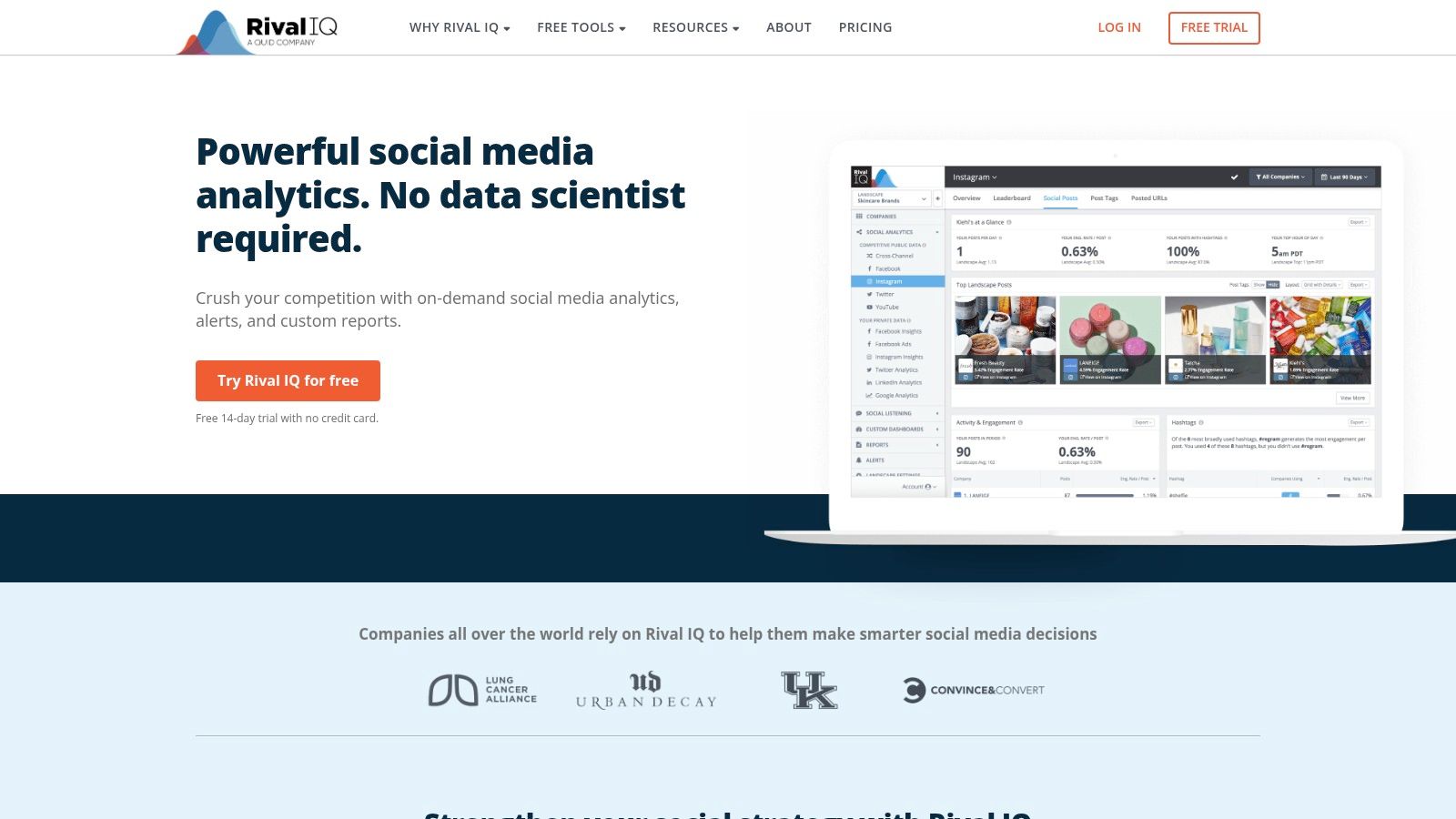
The platform’s strength is its ability to automatically track and analyze competitors you define, delivering alerts and customizable reports that highlight strategic opportunities. A key use case is for product launch campaigns; you can analyze how competitors launched similar products, identify what content resonated with their audience, and use those insights to refine your own launch strategy for maximum impact.
Key Considerations
- Best For: Brands and agencies in competitive industries that need to constantly monitor competitor performance and identify market trends.
- Pricing: Plans begin at $239 per month, with more comprehensive features and larger competitor sets available in higher-priced tiers.
- Limitations: Its primary focus is on analysis and reporting, not publishing or engagement. You will need a separate tool for scheduling and community management. The cost may also be a barrier for smaller businesses that do not have a strong focus on competitive analytics.
- Implementation Tip: Upon setup, create a "landscape" that includes not just your direct competitors but also aspirational brands and industry leaders. This broader view provides richer context, helping you spot emerging trends and content formats before they become mainstream in your specific niche.
Website: https://www.rivaliq.com/
12. Dash Hudson
Dash Hudson is a visual intelligence platform designed for discerning brands that prioritize aesthetics and content performance, particularly on platforms like Instagram, TikTok, and Pinterest. It moves beyond standard metrics by using AI to predict which photos and videos will perform best with a brand's specific audience. This predictive analysis, combined with its in-depth reporting, makes it a powerful tool for creative teams aiming to optimize their content strategy with data-backed insights. Its strength is in connecting creative decisions directly to business outcomes, making it one of the more sophisticated social media reporting tools for lifestyle, e-commerce, and fashion brands.
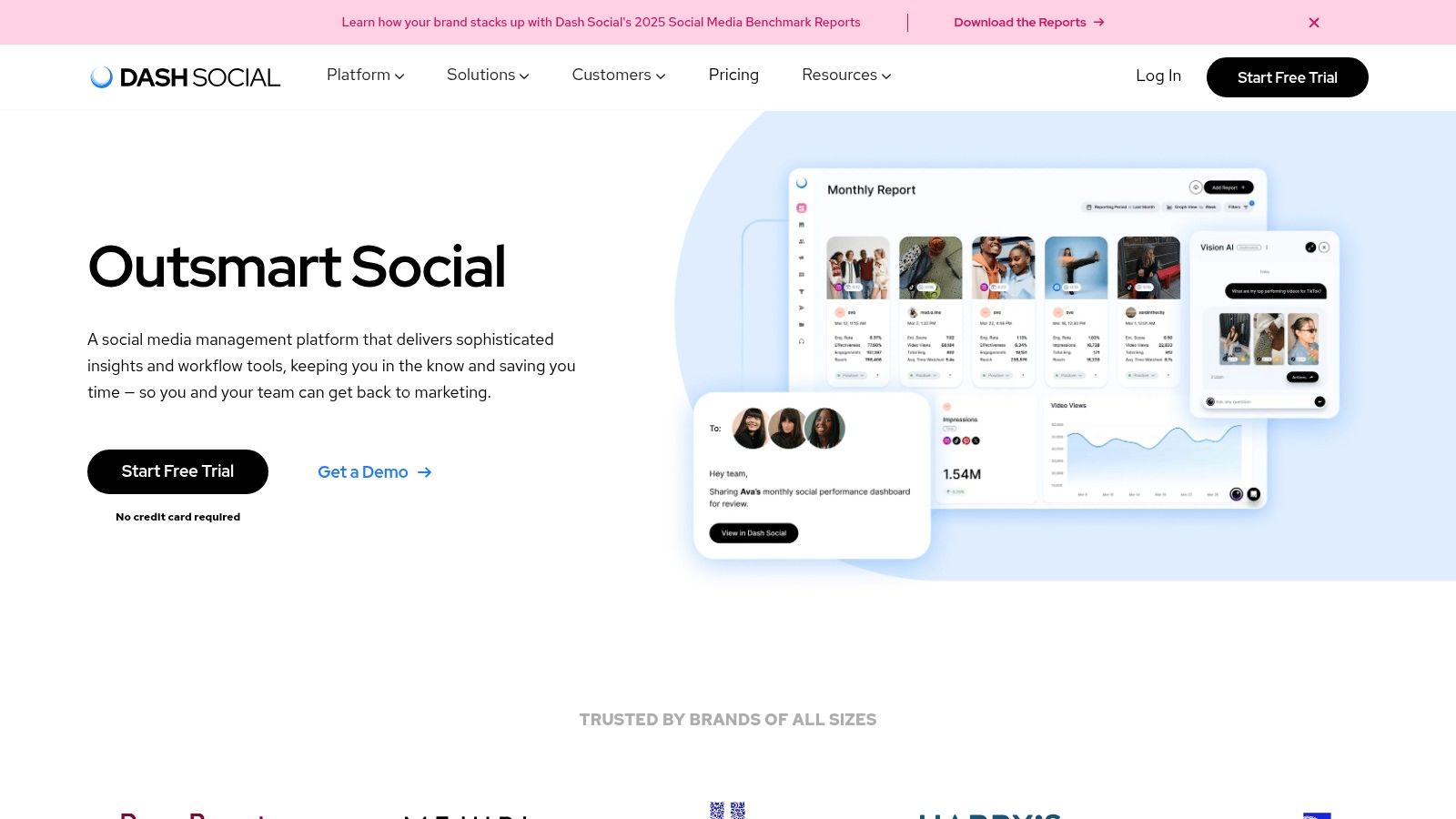
Implementation involves connecting your social and e-commerce accounts to feed its AI engine, Vision. A key use case is for a brand's content team to upload a batch of campaign visuals before posting; Dash Hudson's AI will score and rank them, helping the team select the creative most likely to drive engagement and conversions. This process turns subjective creative choices into a data-driven strategy.
Key Considerations
- Best For: E-commerce, retail, and consumer brands that rely heavily on visual content and want to optimize their creative strategy for maximum ROI.
- Pricing: Dash Hudson uses a custom pricing model based on a brand's specific needs, channels, and audience size. You must request a demo for a quote, indicating a premium price point.
- Limitations: The cost can be a significant barrier for smaller businesses or those not heavily focused on visual-first platforms. Its feature set is highly specialized, so it might not be the best all-in-one solution for teams needing broad B2B or text-focused platform management.
- Implementation Tip: Upon setup, make full use of the content segmentation and relationship insights features. Tagging content by campaign, product category, or visual style allows the platform to deliver more granular reports on what specifically resonates with your audience. Also, connect your e-commerce platform immediately to enable ROI tracking and link creative performance directly to sales.
Website: https://www.dashhudson.com/
Social Media Reporting Tools Comparison
| Tool | Core Features & Capabilities | User Experience & Quality ★★★★☆ | Value Proposition 💰 | Target Audience 👥 | Unique Selling Points ✨ |
|---|---|---|---|---|---|
| Sprout Social | Real-time analytics, AI content suggestions, Inbox | User-friendly, Robust reporting | Premium pricing 💰💰💰 | Teams & enterprises 👥 | AI-driven content optimization, Team collaboration 🏆 |
| Hootsuite | Scheduling, Social listening, Analytics, Integrations | Flexible but less intuitive UI | Varied pricing 💰💰 | All business sizes 👥 | Extensive app integrations, Bulk scheduling ✨ |
| Buffer | Drag-drop calendar, AI captions, Engagement tools | Intuitive, simple to use | Affordable 💰 | Small teams & solopreneurs 👥 | Easy setup, Automated consistent posting 🏆 |
| Brandwatch | Social listening, Sentiment analysis, Influencer tools | Powerful insights, learning curve | Expensive 💰💰💰 | Large enterprises 👥 | Advanced sentiment & brand reputation analysis ✨ |
| Zoho Social | Multi-channel tracking, AI insights, Custom reports | Real-time tracking, budget-friendly | Budget-friendly 💰 | SMBs, Zoho users 👥 | Integration with Zoho ecosystem, Zia AI ✨ |
| Keyhole | Social listening, Real-time tracking, Hashtag monitoring | User-friendly, real-time data | Moderate pricing 💰💰 | Campaign managers 👥 | Hashtag & influencer tracking, Competitive benchmarking ✨ |
| Mention | Monitoring, Social inbox, Scheduling, AI insights | User-friendly interface | Moderate pricing 💰💰 | Reputation managers 👥 | Comprehensive monitoring, Customizable reports ✨ |
| Brand24 | AI insights, Reputation mgmt, Competitor analysis | Easy to use, effective reporting | Moderate pricing 💰💰 | SMBs & reputation teams 👥 | Automated AI reports, Multi-platform listening ✨ |
| DashThis | 30+ marketing integrations, Custom dashboards, Automation | User-friendly for teams | Higher pricing 💰💰💰 | Marketing teams 👥 | Unlimited users, No data source caps ✨ |
| Socialinsider | AI content insights, Competitor & audience analysis | User-friendly, advanced analytics | Higher pricing 💰💰💰 | Content strategists 👥 | AI-driven content pillar insights ✨ |
| Rival IQ | Competitive benchmarking, Social audits, Listening | Easy-to-use interface | Expensive 💰💰💰 | Marketers & analysts 👥 | Deep competitive analysis, Custom reports ✨ |
| Dash Hudson | AI social listening, Creative intelligence, Reports | User-friendly, advanced analytics | Premium pricing 💰💰💰 | Content creators & brands 👥 | Omni-channel AI insights, Creative intelligence ✨ |
Making Your Final Decision on a Reporting Tool
Choosing the right social media reporting tool is less about finding a single "best" option and more about identifying the platform that aligns perfectly with your specific operational needs, strategic goals, and budget. Throughout this guide, we've explored a wide spectrum of solutions, from all-in-one management suites like Sprout Social and Hootsuite to specialized analytics powerhouses such as Rival IQ and Brandwatch. The core takeaway is that data without context is just noise; the best tool for your team will be the one that transforms raw metrics into a clear, actionable roadmap for growth.
Recapping our analysis, we saw how tools like Buffer offer an accessible entry point for startups and individual creators, prioritizing clean reporting and straightforward scheduling. In contrast, enterprise-level solutions like Brandwatch and Dash Hudson provide deep consumer intelligence and visual analytics that are essential for large brands navigating complex market conversations and e-commerce landscapes. Your choice hinges on this fundamental difference in scale and analytical depth.
Key Factors to Guide Your Selection
Before committing to a subscription, move beyond the feature list and evaluate each platform against your team’s practical, day-to-day workflow. Consider these critical factors:
- Team Size and Structure: Does your team consist of dedicated analysts, or do generalist social media managers need to pull reports? Tools like DashThis or Zoho Social are built for accessibility, while platforms like Socialinsider or Keyhole offer more granular data that might require a specialist's eye.
- Integration and Tech Stack: Your social media reporting tool doesn't operate in a vacuum. How well does it integrate with your CRM, analytics platform (like Google Analytics), or other marketing automation tools? A seamless connection can save hundreds of hours and provide a more holistic view of your customer's journey.
- Scalability and Future Needs: The tool that's perfect for you today might not be sufficient a year from now. If you're a fast-growing agency, consider how platforms like Hootsuite or Sprout Social scale with additional clients and team members. Check for pricing tiers that support your growth trajectory without forcing a costly migration later.
- The "So What?" Test: During your free trial, challenge the tool's reporting capabilities. Don't just look at vanity metrics. Can you easily uncover why a particular campaign succeeded or failed? The best social media reporting tools help you answer the "so what?" behind the data, providing insights that directly inform your next strategic move.
Ultimately, the goal is to find a partner in your strategic process. The right tool will not only save you time on manual data collection but will also empower your team to make smarter, data-driven decisions that elevate your brand's presence and impact. Take advantage of free trials, run your own data through the platforms, and ask tough questions of their support teams. This due diligence ensures your investment will pay dividends in clarity and strategic direction.
And while powerful reporting tools give you the insights to refine your strategy, effective execution is just as critical. A well-planned content calendar is the backbone of any successful social media presence. If you're a developer or part of a team looking for a more powerful, API-first approach to social media scheduling, check out LATE to see how you can automate and scale your content pipeline.